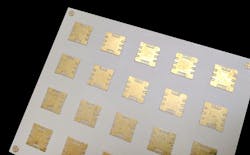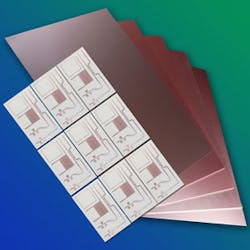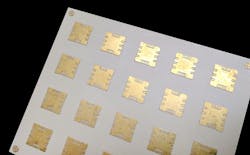Circuit materials form the foundations for high-frequency designs, from the semiconductor to system levels. In particular, circuit-level materials tend to be taken for granted, even though the choice of a printed-circuit-board (PCB) material can impact the ultimate performance achievable with an RF/microwave circuit design. Hopefully, this quick review of some of these building-block materials used in high-frequency circuits and components can help designers better match a particular material to a design goal, even at the highest frequencies.
This file type includes high resolution graphics and schematics when applicable.
Extracting the most performance from a PCB material involves a combination of choosing the right material and then applying the best PCB production process with the least errors and tightest tolerances. A PCB manufacturing facility with carefully monitored and controlled processes can often deliver better performance with low-cost circuit materials than one with lower-quality manufacturing processes and higher-cost circuit materials.
The choice of a PCB manufacturing facility should not be a casual decision. Considerations to factor in include the types of circuits to be manufactured, the required circuit tolerances, the number of component and device placements, and even the volume of PCBs to be manufactured.
Before that choice can be made, though, it’s necessary to sort through a variety of circuit materials to find a suitable starting point for a PCB. High-frequency PCBs were once mostly single-sided constructions based on rigid, ceramic-based dielectric boards or more flexible, dielectric materials often based on polytetrafluoroethylene (PTFE) materials. Modern circuit-board materials are typically composites, often blending woven glass with a dielectric base material to achieve strength and consistency.
Sorting through current, commercially available PCB materials is a matter of comparing different key material characteristics and how a given material’s behavior can be expected to support an application of interest. Frequency range, RF/microwave power levels, and operating-temperature range will help determine which PCB materials are likely candidates from the many materials available on the market.
Key circuit materials to compare include relative permittivity or dielectric constant (also known by the abbreviation of εr), dissipation factor, thermal conductivity, glass transition temperature (Tg), loss tangent, dielectric breakdown voltage, and material thickness and thickness tolerance. Material selection should entail a process of comparing multiple material parameters, since they tend to be inter-related.
For example, a material with a high dielectric constant enables miniaturized circuits; but, in the case of a power amplifier, it may lack the thermal conductivity to effectively dissipate excess heat from the active circuitry. Furthermore, a circuit material with dielectric constant that exhibits a wide frequency variation may serve a narrowband design but not work all that well for broadband circuitry. In addition, circuit material with some favorable parameters may fall short in other areas, such as the capability to withstand the rigors of lead-free (RoHS) circuit processing. One should consider as many circuit parameters as possible when comparing PCB parameters for a particular application.
Dielectric Decisions
Circuit designers typically start with dielectric constant when sorting through different PCB materials. The dielectric constant of a PCB will determine the dimensions of the transmission lines fabricated on that PCB for a given frequency or frequency range, with higher dielectric constant values translating into smaller circuits and transmission-line dimensions. The dielectric constant is a measure of a material’s capability to store charge, as in a capacitor fabricated on that material. Higher dielectric constants denote greater charge-storing capacity for a given voltage.
The “relative” dielectric constant of a material is relative to the value of a vacuum (unity) or dry air (close to unity), and can be measured with a proper test fixture and a microwave vector network analyzer (VNA). Dielectric-constant values listed by different manufacturers for their PCB materials derive from these measurements, and the measurement method and particular conditions, including frequency, are usually listed along with the dielectric-constant values.
Some manufacturers will list typical values of dielectric constant while others may list multiple values of dielectric constant for different frequencies. And, as materials specifiers should be aware, the value of a material’s dielectric constant does change with frequency as well as with temperature. Also, when choosing a material for an application at a specific frequency, dielectric-constant values should be compared for test conditions as close as possible to that frequency of interest.
It should also be noted that circuit materials are anisotropic in terms of dielectric constant, with different values of dielectric constant in the x, y, and z axes of the material. Comparisons of different materials should match axes for axes. PCB dielectric constant will also vary according to variations in a material’s thickness. For applications that require tight control of dielectric constant, such as in impedance matching of transmission lines and other circuit structures, PCB thickness should also feature tight tolerance.
Modern computer-aided-engineering (CAE) software simulation programs (see "Simulators Predict System-Level Behavior") may contain models for particular brands and models of PCB materials based on the published values of dielectric constant at particular frequencies. Or, they may allow a user to enter values of dielectric constant at different frequencies when calculating the performance of a designed circuit on a particular PCB material. Some PCB suppliers, such as Rogers Corp., will even supply dielectric-constant values that they term as “Design Dk” values, which are measured at different frequencies and conditions for use with a commercial CAE program to obtain optimum simulation results.
Taking the Temperature
Thermal conductivity in a PCB is important for higher-power circuits—high thermal conductivity translates into effective heat flow from a power source to a heat sink. It’s determined by a number of material factors, including the type of dielectric material, the area of heat flow, the thickness of the copper conductor, any type of plating finish used with the copper conductor, and even the surface roughness of the copper conductor.
Thermal conductivity will be less of a consideration when choosing PCB materials for small-signal, lower-power applications, which typically generate less heat. Still, even in small-signal applications, the high density of modern circuit applications can result in “hotspots” throughout a circuit board, and good thermal conductivity can contribute to the long-term reliability of even a small-signal circuit design.
A PCB material’s glass transition temperature (Tg) refers to the temperature at which a dramatic change takes place in the material’s coefficient of expansion, or its tendency to expand with increasing temperature. Because a material’s expansion is limited in the x and y axes due to the large volume of material in those axes, most of the expansion above Tg will occur in the z axis or thickness of the material. This will cause stress on plated through holes and viaholes in a PCB material above Tg, since the dielectric material will expand while the plated metal (copper) will not expand.
The Tg of a PCB material is a consideration not only for operational temperatures, but during any manufacturing processes (e.g., soldering operations) that may yield high temperatures and failed circuit boards. Another critical temperature parameter for PCBs is the decomposition temperature (Td), which is essentially the temperature at which the material begins to melt.
A PCB can suffer electromagnetic (EM) signal loss due to both its dielectric and conductor materials. The conductors, for example, can lose energy as a result of propagation reflections that occur at impedance mismatches at circuit interfaces, such as transmission-line junctions.
Signal loss may also occur from absorption of EM energy by the dielectric material, otherwise known as the material’s loss tangent. Dielectric breakdown voltage simply refers to the highest short-term voltage that a circuit material can survive without damage. While this circuit parameter is more commonly a concern for designers of digital circuits, it can come into play for any circuits that encounter high voltages.
These are just some of the parameters used to characterize PCB materials. While not a complete picture, they provide a good starting point when comparing different commercial materials for a given application.
Factoring in Cost
Cost, of course, is another key parameter, and it may dictate which circuit material will be used for an application. Low-cost FR-4 circuit materials, for example, are often used as a reference to specify circuit materials for RF/microwave applications. However, they tend to be limited in terms of their capabilities when compared to newer (and more expensive) circuit materials developed for higher-frequency applications.
FR-4 circuit materials consist of woven fiberglass covered with epoxy. They exhibit high loss, but are often used for mixed-signal, analog, and digital circuits through about 3 GHz. These rigid circuit materials aren’t meant to be flexible, and can handle temperatures to about +120°C before melting, so manufacturing processes must be maintained at lower temperatures accordingly.
Though FR-4 materials are popular from a cost perspective, they lack the stability and consistency of dielectric constant available from more expensive PCB materials. G10 FR-4 materials are a variant of standard FR-4 materials, developed to handle higher temperatures and higher moisture environments.
More-flexible, though higher-cost, PTFE-based circuit materials often will be used for higher-frequency applications that are less tolerant of loss. Unlike FR-4, however, PTFE has several special circuit-board processing requirements, including preparation of viaholes through a circuit board to create plated through holes for multilayer circuits. For those in need of additional details on how FR-4 and PTFE materials compare, Isola provides the white paper “FAQs for Selecting PCB Materials for RF/MW” as a free download from its website.
How Do the Latest Materials Stack Up?
Some newer, higher-performance circuit materials were evaluated as examples of how parameters might compare for different circuit materials. One such material, Rogers Corp.’s 4835 circuit material (Fig. 1), has a typical dielectric constant of 3.48 in the z-axis at 10 GHz, held to a tolerance of ±0.05 across the board. It features a dissipation factor of 0.0037, also through the z-axis at 10 GHz.
This high-performance material is compatible with lead-free processes, and can be fabricated with standard FR-4 processes, although the material shows some impressive thermal characteristics. It offers a Tg of better than +280°C and a Td of +390°C, with a thermal coefficient of dielectric constant of +50 ppm/°C in the z-axis from –100 to +250°C. Its low thermal conductivity of 0.66 W/m/K makes this material a serious candidate for high-power amplifiers and phased-array radar systems. It suits critical, high-volume applications, such as collision-avoidance millimeter-wave radar systems in the automotive arena.
The ULTRALAM 3850HT circuit laminates from Rogers Corp. (Fig. 2) also features a low typical dielectric constant of 3.14 in the z-axis at 10 GHz. It has a dissipation factor of 0.0037, which is once again through the z-axis at 10 GHz. Thermal conductivity is a low 0.2 W/m/K. The material is well suited for mobile applications requiring high flexibility and low moisture absorption.
This file type includes high resolution graphics and schematics when applicable.
As noted earlier, cost can be a key parameter when choosing a PCB material for an application. But when also considering performance and achieving higher yields from a production process (especially when higher temperatures are required), the higher initial costs of some circuit-material types may deliver higher yields and lower final costs than materials such as FR-4, which save on cost from the outset.
About the Author
Jack Browne
Technical Contributor
Jack Browne, Technical Contributor, has worked in technical publishing for over 30 years. He managed the content and production of three technical journals while at the American Institute of Physics, including Medical Physics and the Journal of Vacuum Science & Technology. He has been a Publisher and Editor for Penton Media, started the firm’s Wireless Symposium & Exhibition trade show in 1993, and currently serves as Technical Contributor for that company's Microwaves & RF magazine. Browne, who holds a BS in Mathematics from City College of New York and BA degrees in English and Philosophy from Fordham University, is a member of the IEEE.



